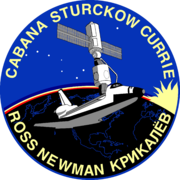STS-88

Endeavour, docked to Unity, moves the Zarya spacecraft into position for mating
|
|
| Mission type | ISS assembly |
|---|---|
| Operator | NASA |
| COSPAR ID | 1998-069A |
| SATCAT no. | 25549 |
| Mission duration | 11 days, 19 hours, 18 minutes, 47 seconds. |
| Distance travelled | 7,600,000 kilometers (4,700,000 mi) |
| Orbits completed | 185 |
| Spacecraft properties | |
| Spacecraft | Space Shuttle Endeavour |
| Launch mass | 119,715 kilograms (263,927 lb) |
| Landing mass | 90,853 kilograms (200,296 lb) |
| Crew | |
| Crew size | 6 |
| Members |
Robert D. Cabana Frederick W. Sturckow Jerry L. Ross Nancy J. Currie James H. Newman Sergei K. Krikalev |
| Start of mission | |
| Launch date | 4 December 1998, 08:35:34 UTC |
| Launch site | Kennedy LC-39A |
| End of mission | |
| Landing date | 16 December 1998, 03:53 UTC |
| Landing site | Kennedy SLF Runway 15 |
| Orbital parameters | |
| Reference system | Geocentric |
| Regime | Low Earth |
| Perigee | 388 kilometres (241 mi) |
| Apogee | 401 kilometres (249 mi) |
| Inclination | 51.6 degrees |
| Period | 92.4 minutes |
| Docking with ISS | |
| Docking port |
Zarya forward (via PMA-2, Unity and PMA-1) |
| Docking date | 7 December 1998, 02:07 UTC |
| Undocking date | 13 December 1998, 20:24 UTC |
| Time docked | 6 days, 18 hours 17 minutes |
 Left to right - Front: Krikalev, Currie; Back: Ross, Cabana, Sturckow, Newman |
|
STS-88 was the first Space Shuttle mission to the International Space Station (ISS). It was flown by Space Shuttle Endeavour, and took the first American module, the Unity node, to the station.
The seven-day mission was highlighted by the mating of the U.S.-built Unity node to the Functional Cargo Block (Zarya module) already in orbit, and three spacewalks to connect power and data transmission cables between the Node and the FGB. Zarya, built by Boeing and the Russian Space Agency, was launched on a Russian Proton rocket from the Baikonur Cosmodrome in Kazakhstan in November 1998.
Other payloads on the STS-88 mission included the IMAX Cargo Bay Camera (ICBC), the Argentine Scientific Applications Satellite-S (SAC-A), the MightySat 1 Hitchhiker payload, the Space Experiment Module (SEM-07) and Getaway Special G-093 sponsored by the University of Michigan.
Node 1, named Unity, was the first space station hardware delivered by the space shuttle. It has two Pressurized Mating Adapters (PMA), one attached to either end. One PMA is permanently mated to Zarya, and the other is used for orbiter dockings and crew access to the station. Unity also contains an International Standard Payload Rack used to support on-orbit activities, which was activated after the fifth Shuttle/Station assembly flight.
To begin the assembly sequence, the crew conducted a series of rendezvous maneuvers similar to those conducted on other Shuttle missions to reach the orbiting FGB. On the way, Currie used the Shuttle's robot arm to place Node 1 atop the Orbiter Docking System. Cabana completed the rendezvous by flying Endeavour to within 10 metres (33 ft) of the FGB, allowing Currie to capture the FGB with the robot arm and place it on the Node's Pressurized Mating Adapter.
...
Wikipedia

